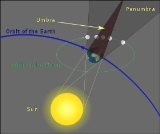
Lunar eclipse
Overview
Moon
The Moon is Earth's only known natural satellite,There are a number of near-Earth asteroids including 3753 Cruithne that are co-orbital with Earth: their orbits bring them close to Earth for periods of time but then alter in the long term . These are quasi-satellites and not true moons. For more...
passes behind the Earth
Earth
Earth is the third planet from the Sun, and the densest and fifth-largest of the eight planets in the Solar System. It is also the largest of the Solar System's four terrestrial planets...
so that the Earth blocks the Sun
Sun
The Sun is the star at the center of the Solar System. It is almost perfectly spherical and consists of hot plasma interwoven with magnetic fields...
's rays from striking the Moon. This can occur only when the Sun, Earth, and Moon are aligned exactly, or very closely so, with the Earth in the middle. Hence, a lunar eclipse can only occur the night of a full moon
Full moon
Full moon lunar phase that occurs when the Moon is on the opposite side of the Earth from the Sun. More precisely, a full moon occurs when the geocentric apparent longitudes of the Sun and Moon differ by 180 degrees; the Moon is then in opposition with the Sun.Lunar eclipses can only occur at...
. The type and length of an eclipse depend upon the Moon's location relative to its orbital node
Lunar node
The lunar nodes are the orbital nodes of the Moon, that is, the points where the orbit of the Moon crosses the ecliptic . The ascending node is where the moon crosses to the north of the ecliptic...
s. The most recent total lunar eclipse
June 2011 lunar eclipse
A total lunar eclipse took place on June 15, 2011. It was the first of two such eclipses in 2011. The second will occur on December 10, 2011.This was a relatively rare central lunar eclipse, in which the center point of Earth's shadow passes across the Moon. The last time a lunar eclipse was closer...
occurred on June 15, 2011; it was a central eclipse, visible over Europe and South America after sunset, over Africa and most of Asia, and Australia before sunrise.
Unanswered Questions
Discussions

